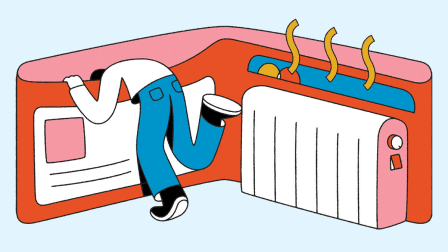Cut Your Bills by More Than $800 a Month
Heat, gas, phone service, electricity, insurance, and internet plans all cost more these days. Our expert strategies can help you trim your monthly expenses.

Is each utility bill you get higher than the last? Does the monthly tally of your streaming services make you shake your head in disbelief? The high cost of living has many of us shelling out far more than we’d like to for these regular expenses.
While you can’t control all of your recurring bills, you can make a sizable dent in many of them. We talked with experts across the U.S. about how to unearth hidden discounts, negotiate better deals, and make small, efficient changes in habits that will lead to a lower monthly nut.
Case in point: Reassessing your insurance needs may save you up to $83 a month ($996 a year), while sealing up drafty areas of your home can cut energy costs up to $27 a month ($324 a year), according to CR’s analysis. Those are broad estimates, and your actual savings depend on factors such as where you live. But the following tips should help almost everyone cut their bills—and they don’t require pricey renovations.
Seal Up Drafts
Check areas such as your attic and basement for spots that feel unusually cold. Or hold a lighted candle or stick of incense as you walk through your home, especially near windows and doors. Wavering smoke will indicate where there are drafts. To help keep your energy dollars from going out the window (and other areas), place draft stoppers under doors, put caulking around leaky windows, and seal cracks and gaps throughout your home. And close the damper when your fireplace isn’t in use.
Want more information? A home energy assessor can do a comprehensive energy audit and tell you, for instance, whether you’d benefit from more insulation. Your utility or state energy office may offer this service free or at a low cost. Or search on the Department of Energy website for professional home energy assessments. You’ll also find tips there on how to assess your home energy use on your own. Small improvements can add up, amounting to $27 a month or more.
Use Your Thermostats Strategically
Chilly outside? Lowering your thermostat by 7° to 10° F for 8 hours a day can save up to 10 percent a year on your heating costs. Many thermostats are programmable, and smart thermostats (which start at about $60) allow you to adjust your home heating and air conditioning remotely.
Make Your Water Heater More Efficient
Wrapping the tank of your water heater in an insulating jacket (about $30 and up) could save you 7 to 16 percent annually on your electric bill. Setting the water temperature to 120° F rather than 140° F is another money-saving move.

Illustration: Pete Ryan Illustration: Pete Ryan
Keep HVAC Filters Clean
Change your heating and cooling systems’ disposable filters as often as the manufacturer recommends. Clogged filters reduce airflow and make your HVAC work harder—and cleaning them could save around $11 a month. See our review of the best air filters for your furnace and central air conditioning system.
End Insurance Sticker Shock
In 2024, the annual insurance premium for a typical homeowner was $3,303—a hike of $648, on average, from 2021, according to the Consumer Federation of America. This year, automobile coverage cost consumers an average of $2,677, about a 12 percent jump from 2024, Bankrate says. Try the cost-cutting strategies here.
Consider an Independent Agent
An independent agent can help you compare costs and options from multiple insurers. Not everyone needs one, but in a complicated insurance market, an agent can save you money, says Michael DeLong, research and advocacy associate at the nonprofit Consumer Federation of America. Expect to pay a fee of 2 to 8 percent of your premium. You can find independent agents at trustedchoice.com.
Shop Around for Insurance
Each insurer may calculate your premiums differently, so get quotes from several. These homeowners insurance and car insurance companies scored highest in our member surveys.
Reassess Your Coverage
With car insurance, collision covers damages from a crash, and comprehensive covers other kinds of incidents, including theft or a broken windshield. Both kinds of coverage are optional if you own your car outright (with no lease or loan). You may want to drop them if your annual premium is higher than 10 percent of your car’s value, DeLong says—as long as you can comfortably pay out of pocket if a problem occurs. For home insurance, reducing coverage on your personal property can save you money as well, but the amount will depend on your home, carrier, and where you live. Reducing insurance coverage could save many people an estimated $83 a month.
Increase Your Deductibles
Raising a $500 deductible up to $1,000 can cut an insurance premium by 25 percent, according to Loretta Worters, vice president of media relations for the Insurance Information Institute. For some people, that could mean $125 a month in their pocket.
Check for Group Deals
Insurers may offer special savings to certain groups. Geico, for instance, gives a discount of up to 15 percent to veterans as well as breaks to members of some college alumni associations, fraternities, and sororities.
Ask About Other Discounts
Taking a defensive driving class can net you a 10 percent break on car insurance. You may also save if you use an app that allows your insurer to monitor your driving habits, including whether you use your phone while driving. (Before you sign on, ask whether the insurer will share or sell your data.) If you drive less than 10,000 miles a year, you may save 5 to 20 percent, on average. At home, installing a security system may save you an average of $100 a year, says Michael Barrett of the Barrett Insurance Agency in St. Johnsbury, Vt.
Price Out Insurance Bundles
When you’re comparing estimates from multiple insurers, see whether you’ll save by getting both your home and car insurance from the same company. CR estimates that policy holders could save $149 a month.
Save on Gasoline Now
CR shows you how to save at the pump and shares these 10 tips to get the most out of a tank of gas.
Cut Cable and Streaming Fees
Consumers pay an average of $125 a month for cable or satellite TV and $69 for streaming services, according to a recent survey from Deloitte—and that doesn’t include what we’re spending on audiobook and music streaming services. These tips can help you get the programs, tunes, and books you want for much less.

Illustration: Pete Ryan Illustration: Pete Ryan
Price a Package
A multiservice bundle may leave more cash in your pocket. For example, with Apple One, you get six subscriptions—including Apple TV+, Apple Music, and Apple News+—for $38 a month. You’d pay about $67 for these subscriptions if you signed up for them separately. You can also get music, podcasts, and one Audible audiobook a month with Amazon Music Unlimited for $12 a month without paying for a Prime membership.
Request a Better Rate
Call the customer retention team at your cable provider. Say you’re considering canceling and ask what they can offer you, says Andrea Woroch, a consumer finance expert. In some cases, you may get a discount of 10 to 20 percent. "If you’re not getting anywhere with the person you’re speaking with, hang up and call again," she says.
Use Free Trials Strategically
If a streaming service just has one or two shows you’re interested in, you can sign up for a trial, watch your series, and then quit. Apps like Bobby, Rocket Money, and Subby will remind you to cancel before the free trial ends. You can rejoin when your favorites return. Websites and apps like JustWatch and Reelgood tell you when new episodes are available.
Watch With Commercials
Ad-supported entertainment options usually cost less than others. For instance, HBO Max is $10 a month with ads and $17 ad-free, while the music service Spotify with ads is free but $12 a month with no ads. Then there are the no-cost streaming services like Pluto TV, the Roku Channel, and Tubi, which are available only with ads. And don’t discount your local library, where you can borrow movies, e-books, and audiobooks absolutely free.
Try the Buddy System
Password sharing generally goes against streaming services’ terms of service. But you may be able to legitimately include an outside-the-family member or two in a plan and split the bill, Woroch says. Take Netflix, where an ad-free plan is $18 a month and adding someone outside your household is $9 extra. To make this simple, you could have one person handle the billing and the co-streamer send them a portion of the payment.
Shrink Phone and Internet Bills
These days, the average monthly phone bill is $140. In 2024, the average monthly cost for internet access was $81. Try the following to reduce your spending on these services.
Don’t Overpay for Data
For simple functions, such as responding to email and browsing the internet, as well as occasionally streaming videos and music, you really don’t need unlimited data. Unlimited plans have become the norm for big carriers, but smaller providers promote limited data plans. And as little as 2 gigabytes might be sufficient for two people. "Start low and upgrade if needed," says Herb Weisbaum, a contributing editor at the nonprofit Consumers’ Checkbook. You can make the most of a smaller data plan by streaming and downloading files only when you’re on WiFi, because doing so won’t count toward data usage on your phone.
Bundle to Save More
Some internet providers offer packages that include several kinds of services, such as television and streaming. For instance, this fall Optimum fiber internet prices started at $55 a month and the company’s phone plan was $35 a month. But customers who opted for both Optimum’s fiber internet and phone plan could get the bundle for $45 a month. See what providers in your area are offering and whether it will net you some savings.
Check Out Other Providers
Great deals are often only for new customers, so it may be worth switching to a new provider. For instance, at publication time, Consumer Cellular was offering a $50-per-month unlimited data plan for one line for people ages 50 and older. And US Mobile had plans starting at $10 per month for 2GB of data. A number of smaller companies routinely outperform AT&T, T-Mobile, and Verizon in CR’s cellular ratings, which are based on large surveys of our members.
Go Paperless
Setting up auto pay and paperless billing may be a cost-cutter. For example, you can save up to $10 monthly on each phone line at Verizon and AT&T this way. If you’re thinking about a new wireless carrier, three high scorers are US Mobile, Consumer Cellular, and Mint Mobile.
Cancel Subscriptions and Services More Easily
Check the app or website. Log in to your account and go to the cancellation area. (Can’t find it? Look for a phrase like "account details," "membership details," or "manage account.") Note: As you try to cancel, you may receive multiple discount offers to entice you to stay.
Contact companies directly. With services such as gym memberships, you may need to call or email a customer service representative directly to tell them you want to cancel. To make sure your cancellation goes through, ask for written confirmation.
Consider a cancellation service. If you’re having difficulty canceling a service, companies such as PocketGuard and Rocket Money can do it for you. Rocket Money says that you could save up to $740 a year by opting out of your unwanted subscriptions.
Top-Rated Cell Phone Service Providers
These are the top wireless carriers based on value, data service, customer support, and more.
CR's Bill Negotiator Can Help
Bill Negotiator is available to CR members. You enter information about your providers and bill totals. You’ll get an estimate of how much the service could save you.
Then our partners at Billshark, a bill negotiation and subscription-canceling business, will work with internet, phone, and other service providers to lower your bills. Your fee will be 35 percent (for paid CR members) to 40 percent (for Basic, or free, CR members) of what the service saves you.
So if the service gets one of your bills down by $15 a month for 12 months, you’ll save $117. That’s $180 minus the $63 fee.
Editor’s Note: This article also appeared in the November/December 2025 issue of Consumer Reports magazine.




















